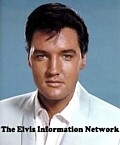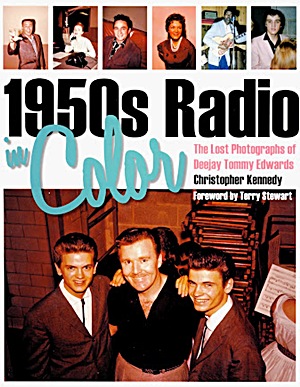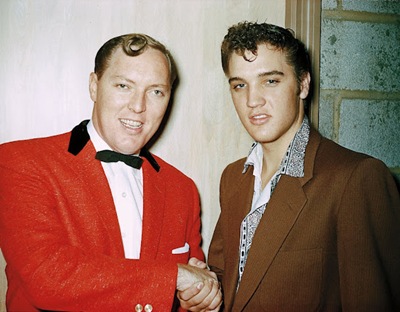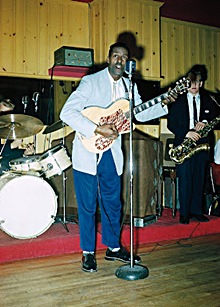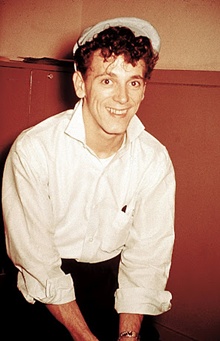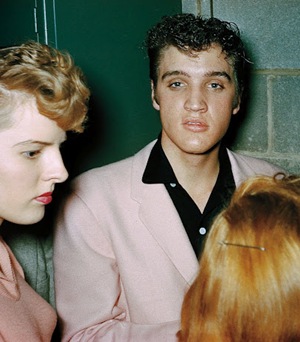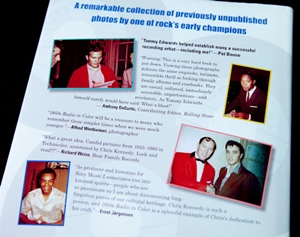 |
 |

Tommy Edwards was one of the most successful and innovative deejays in Cleveland history, alongside his professional rival, Bill Randle. He also hosted local TV shows like Farm Bureau Jamboree, which showcased country and rockabilly artists. The deejay was so loved by his audience that if he believed a single was worthwhile, it virtually guaranteed the artist would become a star. Plus, he photographed hundreds of recording artists, movie stars, and other personalities with a remarkable passion. Tommy Edwards was definitely an innovator, but more importantly, he documented hundreds of artists during their rise to fame. Sadly, the deejay passed away in 1981 before he could be adequately recognized for his crucial contributions to early rock 'n' roll. Nearly 30 years would then roll by before his images were discovered in a box under his nephew's workbench. Jeremy Roberts notes that after interviewing Kennedy, it was clear he was a huge admirer of '50s pop culture. Indeed, it was his investigation into the whereabouts of the highly sought after but still lost concert film, The Pied Piper of Cleveland, that kicked off 1950s Radio In Color. Incidentally, The Pied Piper documented the first time Elvis was filmed by a professional camera [October 1955].
Featuring accompanying text, analysis of each year the pictures were taken (1955-1960), brief bios, and each photo placed within historical context, the book is an essential purchase (see EIN's detailed review - Click here). And if you're curious, the Rock and Roll Hall of Fame will curate an Edwards' photo exhibit beginning January 12 through April 2012. (go here for more Hall Of Fame exhibit info) Below is a special edited version of the lengthy 3-part interview.
Jeremy Roberts: In 2006 you discovered the lost photo collection of popular 1950s Cleveland radio deejay Tommy Edwards. Did you immediately know it was an extraordinary find?
As you can imagine, when I heard this, my imagination ran wild regarding what the collection might contain. I wasn't disappointed. With his camera and newsletters, Tommy Edwards captured the rock 'n' roll explosion, as well as 1950s pop culture, as never before seen or documented. When I saw how beautiful and historically important his photographs were, I knew they should be shared. I knew what type of book the photographs should be presented in, having many photography, art and music books in my own library. So I just approached the project as passionately as I did my recording career, writing songs and getting record deals. In my mind there was never a question whether I could do it, I just had to work out the details. Call it a false sense of confidence coupled with blind ambition. For me, that's a potent combination. JR: Name a few artists from the '50s you especially admire.
- Johnny Cash – I remember meeting him backstage at a show on October 28, 1989, at The Ritz in New York City, right before he went onstage, and how he was shaking and trembling. I think of my father playing his records. I think of how no one will ever be that cool again. (below right)
Tommy had his ear to the ground and knew that the record was making some waves in the South. So in late 1954 he began spinning it, and the northern audience reacted.
JR: Once Elvis became a national phenomenon, Tommy opined that Elvis wasn't recording country (aka hillbilly music) anymore. So, did Tommy come to accept Elvis' new direction with rock music?
JR: Who were some of your memorable interviews? In my interview with Charlie Louvin, he spoke very candidly about his brother, Ira, which added to the intimacy of their photograph. George Darro, the rockabilly artist from Pennsylvania, has had a tough life but maintains this amazingly positive attitude, it's contagious. Also, Jackie Jocko was inspiring and fun. It was insightful to interview a few of Tommy's girlfriends, who were able to add a very human side to his story. Many of women I interviewed, such as Wanda Jackson, Dolores Hart, and Beverly Ross, remembered the clothes and jewelry they were wearing; again, adding to the intimacy. The Rock and Roll Hall of Fame will curate a Tommy Edwards photo exhibit beginning January 12 through April 2012. It should be a beautiful show, featuring 32 photographs from the collection. (go here for more Hall Of Fame exhibit info) JR: Do you have a new book project in mind? As a continuation of the seven years of hunting, discovery and research I've done on The Pied Piper of Cleveland missing film project, I'm hoping to write a biography on Bill Randle. He deserves it, and I've been working with his family as well as with my friend, writer David Barnett, on this idea. JR: Is there a reason why Tommy is not widely known today? Tommy was never one to boast about his accomplishments. Reflecting back in a 1981 interview, he said he would have preferred to have a manager or agent to handle the promotional side of things. Professionally, he was a trailblazer and entrepreneur. Personally, he was a loner, and not in the negative sense of the word. It’s my hope that the discovery of Tommy's photographs and newsletters will gain him the recognition as not only one of rock 'n' roll's early champions but also as the deejay responsible for perhaps the most important photographic and written documentation of twentieth-century popular music ever produced.
NOTE - This is an edited version of a lengthy and fascinating interview - To read the complete interview with even more GREAT Tommy Edwards photos and interesting rock'n'roll stories - Click Here. NOTE - The images EIN used in this interview are deliberately low-res cropped scans and do not represent the true STUNNING quality of the pictures in the actual book. Interview by EIN Contributor Jeremy Roberts. Click here to comment on this Interview
EIN Website content © Copyright the Elvis Information Network.
Elvis Presley, Elvis and Graceland are trademarks of Elvis Presley Enterprises. The Elvis Information Network has been running since 1986 and is an EPE officially recognised Elvis fan club.
|
|
